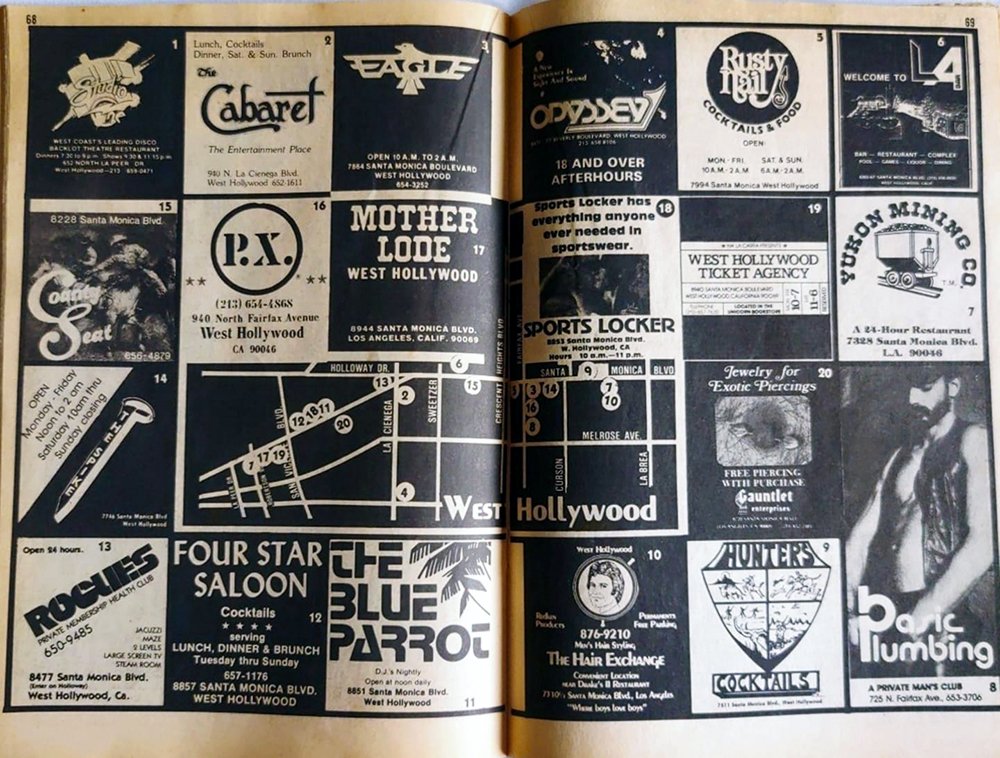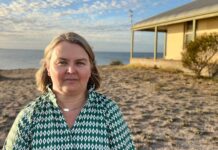Welcome to West Hollywood Boystown! The year is 1981, and if you were a homosexual man (mostly white) looking for some fun in the unincorporated part of Los Angeles County unofficially known as West Hollywood, then you had plenty to choose from in a long list of nightlife gay bars, discos, restaurants, bathhouses and gay-owned businesses catering to the gay-gay-gay!
The image you see above, shared by WeHo history buff Mark Donnell, shows a double spread ad taken from a Data Boy Magazine in 1981, which was one of the gay rags that could be found in local WeHo businesses stacked next to an issue of Frontiers Magazine. The map names places long gone that will never be known to the currently young, but never forgotten by those of a certain age who were lucky to frequent these old WeHo haunts. This was a time before Boystown became part of the more inclusive LGBT Rainbow District we know today.
There were the bars and dance clubs:
We’re looking at the Four Star Saloon which was located at 8857 Santa Monica Boulevard where Micky’s WeHo now stands. Micky’s has been around for well over 30 years. Who here remembers the Four Star?
The Rusty Nail bar was located at 7994 Santa Monica Blvd, eventually becoming the recently defunct FUBAR WeHo. The Rusty Nail was last documented in 1984. Many remember that location as Rafters before it became FUBAR. There is a new bar currently in the works at 7994 by the FUBAR owners, but that probably won’t open for another year or so.
The Eagle was a leather bar located east of Fairfax Avenue at 7654 Santa Monica Blvd. Evidence of its existence is completely gone. It is now a bakery that’s sandwiched between a nail salon and a Thai massage parlor, which is pretty damn heartbreaking.
The Nu-Town Saloon / Sutter’s Place at 8265 Santa Monica boulevard is now a Village Cleaners.
The Spike was a Levi’s and leather bar that turned into a cleaned up and upscale Winston’s Bar. Alas, it didn’t last. The space currently appears to be empty.
There was Studio One at 652 N. LaPeer Drive, which was completely demolished two years ago to make room for a giant hotel and retail space by developer Faring. However, it continues to be an empty lot with overgrown weeds and the occasional homeless encampment. Why is it taking so long?
The Odyssey at 8471 Beverly Boulevard was actually located in Los Angeles at the West Hollywood city limits. According to the ad, it was newly open in 1981. It is now home to a retail space that houses, a Kid’s Playhouse, Lenscrafters, Fed-EX and an AT&T store.
We Have The Blue Parrot bar with its giant panoramic windows. The bird was replaced by Revolver Video Bar, which was replaced by East West Lounge and then replaced back to Revolver Video Bar, which is what currently stands today.
The only West Hollywood bar still standing from that 1981 listing is Mother Lode, which was established in 1979. Mother Lode was upgraded and looks very different than its original 80s version, but for the most part it has managed to stay Mother Lode.
There were the gay-owned clothing stores, restaurants retail spaces:
The Sports Locker was situated at 8853 Santa Monica Boulevard. That retail space is the current home to Block Party WeHo, known for pushing overly priced slut gear and tacky rainbow gay apparel under the guise that is the biggest gay store in the world. 8853 is actually more fondly remembered as the former home to a Different Light Bookstore.
The P.X. clothing store was geared towards gay men (mostly white which was a sign of the times). It is now an unmarked building that’s actually the random home to a Matthew Marks Gallery.
Prime Cuts is fondly remembered by old timers as a record store that bought sold and traded vinyl. It is now yet another massage parlor in West Hollywood
Located at 8720 Santa Monica Boulevard, The Gauntlet, also known as Gauntlet Enterprises, was a body piercing business founded by Jim Ward. It is considered to be the first business of its type in the United States and some say was the beginning of the body piercing industry. Eventually, Gauntlet opened stores in San Francisco, New York City, and Seattle, as well as a franchise in Paris. It was located upstairs from 665, which is now a mostly straight sex shop called Endless Romance.
Yukon Mining Co. was a comfort foods restaurant that catered to drag queens, male hustlers and everything in between. That space is now an unattractive retail in the bottom/condos on top redevelopment.
===
A different version of the same ad appears online which was also taken from Data-Boy magazine and appears to date back to the same timeframe in WeHo Boystown.

 Data-Boy ad from 1981 – WeHo Boystown
Data-Boy ad from 1981 – WeHo BoystownThe second ad adds the County Seat bar which ran from 1979 – 1984 at 8228 Santa Monica Blvd. It would become the home of the beloved Gold Coast Bar, which ran until September 2020. It is now the newly opened and overly-priced OR Bar, which people love and love to hate despite being open for only a hot second.
The Hair Exchange “where boys love boys” at 7310 1/2 Santa Monica Blvd was only open for a year from 1980-1981 according to Queer Maps. It was located in the same stripmall as the Yukon Mining Co.
Then there’s Hunter’s Cocktails bar located at 7511 Santa Monica Blvd., which has been documented from 1981 and to 2000 by One Archives. The space is now a Mexican bar called Las Perlas Mezcal y Cerveza which is east of Gardner Street and across the street from Astro Burger.
Queer Maps documents Data-Boy Magazine at 7512 Santa Monica Blvd (now a butch BDS Sheet Metal & AC Inc contractor), as a gay entertainment magazine launched in 1968 by Data-Boy Instant Press, an early computerized printing service owned by Saul “Fat Shirley” Sufron. Billy Eye, who covered the Punk, New Wave and East L.A. underground music scene in Los Angeles for Data-Boy magazine says the namesake for the magazine was from Sufron’s Yiddish mother who encouraged him with, “Dat a boy.”
The magazine was provided free at various LGBT bars and hangouts. Mostly advertising for local bars, clubs and services, it also included reviews of stage plays and films. In the late 1970s-1980s, it expanded to Northern California and the two publications were bound back to back with appropriate numbering for each. This ended sometime in the mid 1980s when the publication address changed to Los Angeles and the magazine was called California Data-Boy, combining all of the state into one periodical. Additional address found at 7626 Santa Monica Blvd (used to be a Chabad Thrift Shop) was for Data-Boy – An Entertainment Magazine, that ran from May 23, 1985 – September 17, 1992.
To learn more about queer maps, visit: https://queermaps.org/








